How STIHL Chainsaw Protective Chaps Work
- February 9, 2024
- 0 comment
Chainsaws, while essential tools for forestry, landscaping, and certain DIY projects, pose significant risks to operators. The high-speed, sharp chain can cause severe injuries upon contact with the body. Recognizing this hazard, STIHL has developed an innovative solution to enhance user safety: chainsaw protective chaps. These chaps are not just a piece of safety gear but a sophisticated defense mechanism against chainsaw accidents. Here’s how they work.
Design and Materials of STIHL Chainsaw Protective Chaps
STIHL chainsaw protective chaps feature a multi-layered construction designed to provide the utmost protection without compromising on comfort. At their core, these chaps boast six layers of cut-resistant fibers. When a chainsaw comes into contact with the chaps, these fibers become entangled in the chain and sprocket, effectively bringing the saw to a stop. This ingenious mechanism significantly reduces the risk of injury, providing a crucial window of safety.
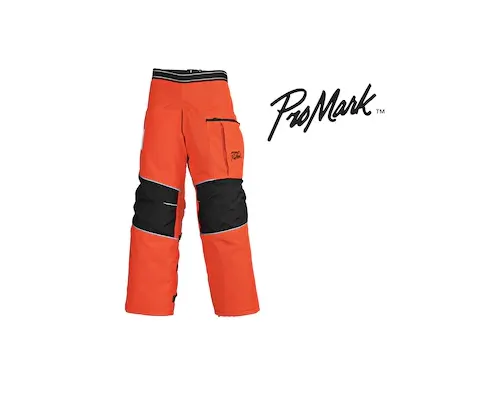
Pro Mark Protective Apparel
- Designed for use with Professional STIHL units
- Ideal for professional users, helping protect against injuries they may face during frequent use
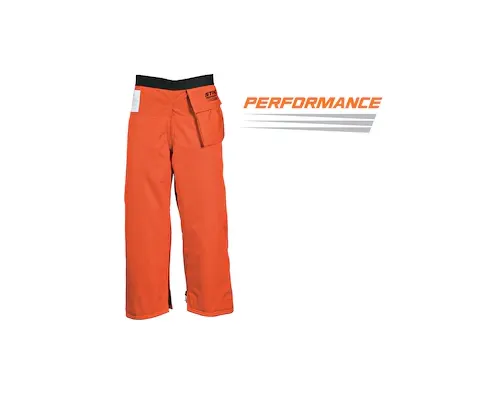
Dynamic Protective Apparel
- Designed for use with Farm & Ranch STIHL units
- Ideal for personal and work-related tasks
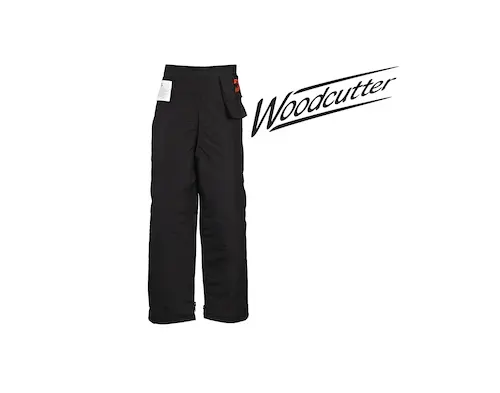
Function Protective Apparel
- Designed for use with Homeowner STIHL units
- Ideal for the occasional user but surpasses the standards requires for personal protective apparel
The chaps are designed with practicality in mind, available in stylish anthracite and high-visibility orange with a denim look. Made from a blend of 65% polyester and 35% cotton, they offer durability while maintaining lightness and breathability. An elastic strap ensures a comfortable fit, and the clip closures at the back maximize air circulation.
Enhanced Safety Features
STIHL has extended the cut protection area beyond the basic requirements, ensuring a wider safety margin. The protective gear meets EN 381 standards, achieving protection class 1 (equivalent to 20 m/s chain speed resistance). Reflective logos enhance visibility, ensuring the wearer is seen in lower light conditions.

The trousers variant, equipped with about nine layers of Dyneema-like fabric, represents the pinnacle of protective technology. Termed as a “blocking fabric,” its coarse fibers are designed to choke or block the chainsaw’s drive sprocket upon contact, effectively stopping the chain in its tracks.
Real-World Efficacy
The effectiveness of STIHL’s chainsaw protective chaps in real-world scenarios is dramatically highlighted through a controlled demonstration, using a STIHL chainsaw fitted with a full chisel chain to simulate an accidental leg contact. In this test, the chaps were placed over a log, effectively standing in for the operator’s leg, and then exposed to the chainsaw’s force. The outcome was definitive; the chainsaw’s teeth, upon contact with the chaps, engaged the embedded cut-resistant fibers designed to protect against such incidents. These fibers quickly entangled with the chainsaw’s chain and drive sprocket, effectively stopping the chain’s movement instantly. This immediate halt prevented the chain from penetrating the chaps and reaching the log underneath, showcasing the chaps’ capability to avert potential injuries by mimicking a real-life scenario where an operator’s leg is protected.
This demonstration underscores the chaps’ potential to significantly reduce the severity of chainsaw-related injuries, serving as a critical safety mechanism. The ability of the protective fibers to jam the drive sprocket and arrest the chainsaw’s motion instantaneously not only proves the chaps’ effectiveness but also reflects STIHL’s dedication to safety through innovation. Such real-world efficacy reinforces the importance of donning appropriate protective gear when operating chainsaws, affirming that even seasoned users stand to benefit from the advanced protective features these chaps offer.
Ensuring Your Chaps Fit Correctly
Incorrect Fit: Too Long
If the chaps are too long, they might catch on objects, creating a hazard.
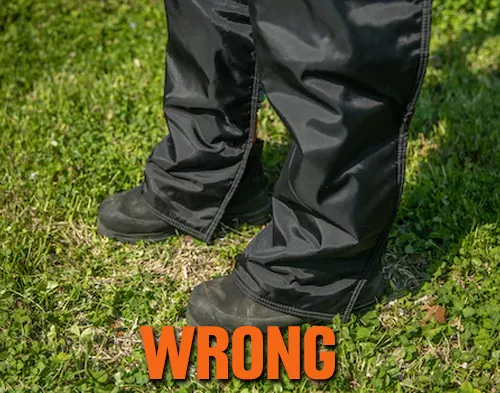
Incorrect Fit: Too Short
Chaps that are too short leave parts of the leg unprotected and exposed to potential injury.
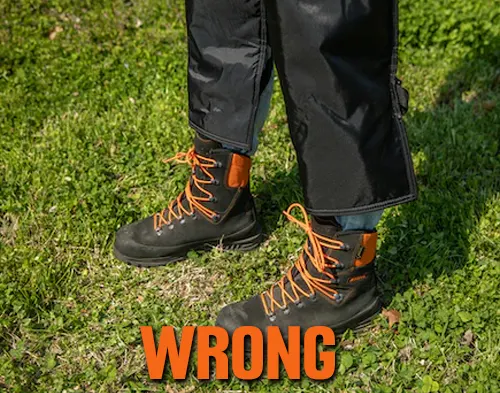
Correct Fit
The chaps should cover the top of the boot but not extend to touch the toe of the boot. The best length for optimal protection and comfort is between the top of the boot and the top of the 2nd or 3rd lace hook, ensuring a snug fit without compromising movement or safety.
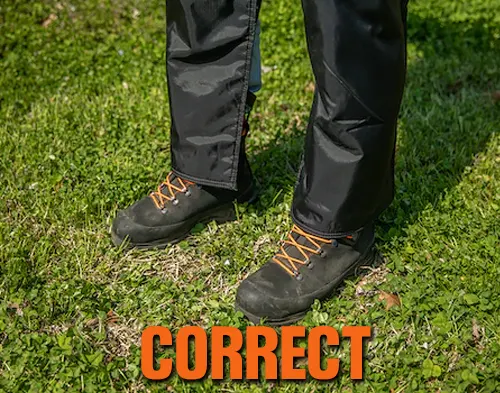
How to Measure Chainsaw Chaps Properly
When selecting the correct size for STIHL chainsaw protective chaps, it’s essential to measure accurately to ensure maximum protection and comfort. STIHL chaps are sized according to their overall length from the waist down. Below is a table that outlines the sizes available and the corresponding measurements for the inseam and outseam. Ensure you measure both your inseam and outseam before choosing a size to find the best fit.
| Sizes | Inseam Measurement | Outseam Measurement |
|---|---|---|
| 32 | 29” – 30” | 32” – 36” |
| 36 | 31” – 32” | 36” – 40” |
| 40 | 32” – 33” | 40” – 44” |
(Note: All inch sizes are approximate.)
Performance Standards Matter
STIHL chaps are not just about size and fit; they are also about safety. They are classified by UL(Underwriter Laboratories Inc.) as chainsaw cut-resistant leg protection, suitable for all operators of gas-powered chainsaws. This classification is based on their adherence to specific testing methods and performance standards, including the ASTM (American Society of Testing & Materials) F1414 Test Method and the ASTM F1897 performance standard. To understand the level of protection each pair of chaps offers, look for the complete marking on the products, which details their certification and ensures they meet the highest safety standards.
Maintenance and Longevity of STIHL Chainsaw Protective Chaps
Proper maintenance is key to ensuring the longevity and continued effectiveness of STIHL chainsaw protective chaps. Adhering to the manufacturer’s guidelines for washing and drying is essential, as it helps maintain the integrity of the chaps’ protective fibers. For peak performance, it is advised to wash the chaps before their initial use.
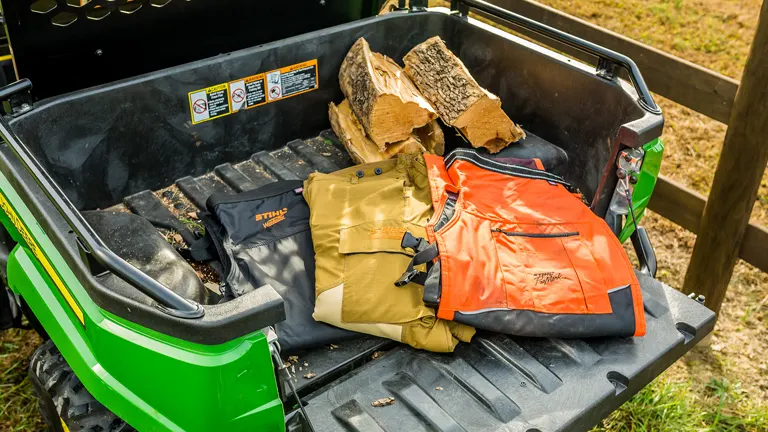
This step is crucial as it primes the fibers, ensuring they offer the maximum level of protection from the get-go. However, the care for these chaps extends beyond regular maintenance. In the event that they come into direct contact with a chainsaw, resulting in the cutting into any of their protective layers, immediate replacement is non-negotiable. This requirement is in place because even a single incident can compromise the chaps’ protective capabilities, potentially leaving the user vulnerable to injury. Thus, ensuring the chaps are properly maintained and promptly replaced if damaged is vital for the safety and security of the chainsaw operator.
How to Wash STIHL Chainsaw Chaps
DO
- Close hook-and-loop fasteners and zippers
- Machine wash in warm water only
- Use mild detergent
- Tumble dry
DO NOT
- Bleach
- Use fabric softener
- Iron
- Dry clean
A Layer in Safety, Not a Replacement for Caution
STIHL chainsaw protective chaps significantly enhance user safety by offering an additional layer of protection. However, it’s crucial to understand that these chaps are not a panacea for all chainsaw-related hazards. The level of protection they offer can vary widely, influenced by several factors such as the speed at which the chainsaw is operating, the angle at which contact occurs, and the saw’s power and torque specifications.

This variability underscores the importance of not solely relying on the chaps for safety. Instead, they should be viewed as part of a comprehensive safety strategy that includes adherence to best practices in chainsaw operation and the use of a full set of personal protective equipment (PPE) as recommended in the chainsaw’s instruction manual. Additionally, it’s crucial not to work alone; always have a partner with you who can assist, especially in the event of an accident or other serious issues where immediate help is needed. The chaps are designed to reduce the risk of injury in the event of an accident, but they work best when combined with knowledgeable and cautious chainsaw use, emphasizing that safety is a multifaceted responsibility.
Conclusion
STIHL’s chainsaw protective chaps are a testament to the brand’s commitment to safety and innovation. By integrating cut-resistant fibers and a sophisticated design that stops a chainsaw in its tracks, these chaps offer an essential layer of protection for chainsaw operators. However, it’s crucial to remember that they are part of a broader safety protocol, including proper chainsaw handling techniques and the use of comprehensive PPE. Stay safe, and ensure you’re always well-equipped when operating a chainsaw.
Related Articles:
- How To Fix A Chainsaw If It Won’t Oil The Bar And Chain
- What Size Chainsaw Do I Need?
- Top Reasons Chainsaw Starts, Then Stalls
- What is the Fuel Mixture for a STIHL Chainsaw?
- How To Replace Echo Chainsaw Chain: 15 Easy Steps
- Can a Chainsaw Chain Be Put on Backwards? How to Fix
FAQs
- How do chainsaw chaps protect you?
Chainsaw chaps protect by using layers of cut-resistant fibers to stop the chainsaw’s chain upon contact, reducing injury risk. - Do chainsaw chaps really work?
Yes, they effectively stop the chainsaw chain when it contacts the protective layers, significantly reducing injury severity. - Can you wash STIHL chainsaw chaps?
Yes, you can wash them following the manufacturer’s instructions to maintain their protective capabilities. - What is the function of chap pants?
Chap pants function to provide a protective barrier against chainsaw injuries by entangling and stopping the chain. - Should you work alone when using a chainsaw?
No, it’s recommended to have a partner for immediate assistance in case of accidents or emergencies.
We hope you found this guide on STIHL chainsaw protective chaps insightful and helpful! Your safety is paramount, and we believe in equipping you with the knowledge to protect yourself effectively. If you have any experiences, tips, or thoughts you’d like to share about using chainsaw protective gear, we’d love to hear from you. Drop a comment below and let’s keep the conversation going. Don’t forget to share this article with friends and family to spread the word on chainsaw safety. Stay safe and happy cutting!

David Murray
Forestry AuthorI'm David Murry, a forestry equipment specialist with a focus on chainsaw operation. With over 13 years of experience, I've honed my skills in operating and maintaining a wide range of machinery, from chainsaws to log splitters. My passion for the outdoors and commitment to sustainable forestry drive my work, which emphasizes safety, efficiency, and staying updated with industry advancements. Additionally, I'm dedicated to sharing my expertise and promoting environmental awareness within the forestry community.












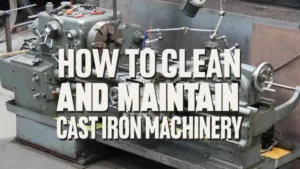
Leave your comment